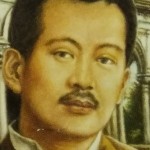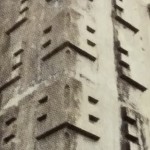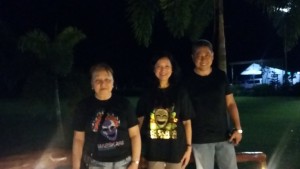I’m a sucker for love stories, and I was enthralled when Raymund Javellana, great grandson of Mariano Lacson personally toured me around his family’s ancestral home in Talisay City, Negros Occidental. Acclaimed as one of the 12 most fascinating ruins of the world, The Ruins is a monument to the undying love of Mariano Lacson and Maria Braga.

It was my second night in Bacolod City, and Mrs. Josefina Puentevella (Tita Paching) was taking me around. She brought me to Talisay to see The Ruins. She said it was a house that was bombed during the Japanese occupation so that the invaders would not use it as headquarters. I told her about my own ancestral home in San Sebastian that was actually used by the Japanese commander as his headquarters. I was thus quite interested to see the house she was referring to which had belonged to Don Mariano Ledesma Lacson, a sugar baron in the early 1900s.

The youngest of ten children of Lucio Lacson and Clara Ledesma, the dashing Mariano fell in love during one of his frequent visits to Hong Kong with the beautiful Maria Braga, a Portuguese lady from Macau, daughter of a ship captain. He proposed to her and brought his young bride home to Negros. There, they lived happily together and had ten children.
When Maria was pregnant with her 11th child, she suffered a bad fall and began to bleed heavily. Alarmed, Mariano quickly drove his horse-drawn carriage to the next city to summon a physician. It took four days of travel traversing different sugar plantations, asking permission to pass from the landowner each time. I can just imagine how distraught he was throughout the trip. By the time he got back with the doctor, Maria and her unborn child was dead.
Grief-stricken, the heartbroken Mariano decided to build a mansion to commemorate his love for his beloved wife. With the help of his father-in-law who sent over workers from Hong Kong, Mariano built an elegant two-story mansion in the midst of his sugar plantation. Here, he lived with his children with the rule that once any of them got married, they would have to leave the mansion.

No expense was spared in building the structure made of oversized steel bars encased in solid concrete. The walls were finished in cement mixed with egg whites, lending a marble-like finish to the mansion. Each post of the house was emblazoned with two letter Ms facing each other, initials of Mariano and Maria.
There were four rooms downstairs for his boys, and four rooms directly on top of them for his girls. A wide staircase led directly from the side entrance to the second floor. This way, Raymund explained, Mariano could go up to the master’s bedroom without disturbing any of the guests in the living room. The family could enjoy sunsets through the bay window of the belvedere facing west.

A wide porch wrapped itself around both floors of the house, reminiscent of the mansion in the movie “Gone with the Wind.” Twin columns lined the porch with graceful arches in between. Colorful Machuca tiles from Spain lined the veranda, while thick meter-wide, 20-meter long wooden planks served as flooring for the various rooms. Starkly silhouetted against the dark sky was the scalloped roof.
On the eve of World War II, this beautiful mansion was razed to the ground by guerillas during the Japanese war upon the orders of the United States Armed Forces in the Far East or USAFFE, to ensure it would not fall into the hands of the Japanese forces and made into headquarters. They say it took three days for the house to burn, engulfing all the beautiful wooden floors and ceiling, leaving behind the shell of the once beautiful mansion.
When Mariano died, the plantation was subdivided amongst his ten children, and later further subdivided amongst the grandchildren. No one wanted the portion of land on which the burnt out shell stood. After all, it was thought to be useless since sugarcane could not be planted in it. For six and a half decades, The Ruins remained just that, a sad reminder of the opulent lifestyle of the sugar barons, slowly succumbing to the ravages of time.
That is, until Raymund Javellana, a scion of the prominent Lacson-Javellana and Lopez-Heredia families, inherited the land with the burnt mansion and pondered what to do with it. Just like his ancestor Mariano, Raymund was widely traveled and had been to many interesting historical places in Europe. He toyed with the idea of developing The Ruins into a tourist attraction.
One day, Raymund saw children climbing up and playing at the four-tiered fountain fronting the house. Looking closely, he noticed how strong and beautiful it was and decided to rehabilitate it, along with the expansive garden surrounding the house. In its heyday, the mansion’s garden laden with imported lilies was maintained by a Japanese gardener under the supervision of Angelina, Mariano’s daughter. This same gardener turned out to be an informant of the Japanese Military.
Raymund installed lights in the house, running the electric wires through the original pipes embedded in the ceiling. I asked him if the globes were made of capiz, but he said they were made from sturdy resin to withstand the strong wind from storms. He showed me where the living room, dining room, kitchen and kitchen preparation areas had been, and pointed to the thick cement flooring underneath where the wood-fired ovens were located.
It’s a pity there are hardly any photos of the house as it was in its prime. Raymund remarked that the old photos were kept by one of the children but they were lost in another fire. “There’s something about our family and fires,” he said.

Walking with us around the beautifully landscaped gardens surrounding the house, Raymund invited us to have a picture taken in front of an outside glass table. He said that most everyone who comes has their photo taken there with the house silhouetted behind, as the glass of the table reflects the house and it appears magical. Naturally, we just had to do this too.
And as I looked around I saw in the distance what seemed like a tree sprouting from a column. I learned that this was the simborio, or smokestack of the sugar farm’s mill where they heated the juice of the sugarcane before allowing it to cool and crystalize into what we know as muscovado, unrefined brown sugar imbued with the strong flavor of molasses.

Just as we were leaving, we passed by the café that Raymund had built and bought piping hot piaya or unleavened flatbread filled with muscovado and glucose syrup. What a treat it was to bite into the delicious piaya! Closing my eyes, I was once again transported to the very first time I had tasted piaya, savoring its goodness, and for a fleeting moment, imagined how beautiful life must have been for Mariano and Maria. And thanks to Raymund, the story of their love will continue to inspire generations to come.
